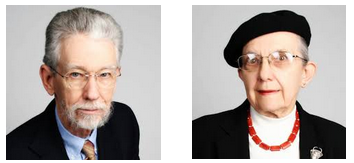The Mathematics Education group of the Department of Mathematical Sciences includes several members involved in a variety of scholarly activities in Mathematics Education. These include Research in Mathematics Education, curriculum development, professional development and outreach activities with teachers. For further information on educational work in the department, click here.
Faculty
 |
|
Patricia Baggett
My main interests are designing and testing mathematics curricular materials for prospective and practicing K-12 teachers, and offering courses that use the materials. I am currently working on some new algorithms for basic operations (addition, subtraction, multiplication, and division) which can be taught in the early grades. I am also developing hands-on applications of calculus, which can be used in high school and college courses. I have co-authored four books of curricular materials and have a website with more materials at my web page “Breaking away from the Mathbook“. My collaborator in all these activities is Andrzej Ehrenfeucht from the University of Colorado.
Emeritus and Adjunct Faculty
Jerry Lodder
Jerry Lodder arrived at New Mexico State University in the late 1980s and very quickly began teaching with novel curricular materials first in conjunction with calculus reform, led by Dr. David Pengelley and supported by the National Science Foundation under grant “Student Research Projects in the Calculus Curriculum,” (1988–1991). Initially these curricular modules developed any application of calculus, but Jerry sought to root the content of the projects in the historical development of the subject in order to offer the original motivation for its study. Moreover, he began to use historical projects in other courses, such as linear algebra, differential equations, discrete mathematics, foundations of geometry, general education, and the Honors course “Great Theorems: The Art of Mathematics.” He has served as a Principal Investigator on four separate grants from the National Science Foundation for the development of curricular
materials based on primary historical sources, namely:
``A Capstone Course: Learning Mathematics Through Original Sources,” 1997–2000.
``Teaching Discrete Mathematics via Original Historical Sources,” 2003–2006.
``Learning Discrete Mathematics and Computer Science via Primary Historical Sources,” 2008–2013.
The first award led to the publication of the text “Mathematical Masterpieces,” which contains Jerry’s chapter on curvature and the notion of higher-dimensional space. This material has expanded to form the content of a great theorems capstone course. In the second award Jerry partnered with mathematics faculty (Guram Bezhanishvili, David Pengelley) and computer science faculty (Hing Leung, Desh Ranjan) to lead an effort to teach foundational courses in discrete mathematics and computer science from historical projects. The resulting curricular materials have been published by the Mathematical Association of America in “Resources for Teaching Discrete Mathematics,” The third award above was a five-year expansion grant designed to bring historical projects to a wide variety of mathematics and computer science courses requiring algorithmic thought. The materials from this grant have been published in several venues, including PRIMUS, “Science & Education,” and “Convergence,” The fourth award (TRIUMPHS) is a five-year grant to bring historical curricular modules to undergraduate courses in almost all areas of mathematics and represents a collaboration of seven institutions, including NMSU.
In 2018 Jerry received the Distinguished Teaching Award from the Southwest Section of the Mathematical Association of America and the Outstanding Faculty Achievement Award in Teaching from the College of Arts and Sciences at NMSU.
 |
|
David Pengelley
My work in mathematics education centers on developing and implementing teaching with student projects and primary historical sources, mostly at the undergraduate level, developing student-centered classroom alternatives to lecturing, and teaching graduate students in some of these areas of mathematics education. This mostly collaborative work has > been supported by seven multi-year grants from the National Science Foundation over a twenty year period, and I have advised a number of Masters students, with several students publishing their research in national publications.
At the beginning of the calculus reform movement in 1988, I led the development of a departmental program of student projects throughout our calculus teaching. Major multi-step problems were used to engage students in imaginative thinking, challenge them to integrate ideas, and express them in a written report. This led to the book “Student Research Projects in Calculus” of 100 calculus projects for instructors. Student projects have become a model included in many calculus courses.
I am now heavily focused on developing primary historical sources in teaching. Studying primary sources fosters motivation, broadens perspective, reveals context, hones verbal and deductive skills, provides excitement, brings students closer to the practice of research, shows the genesis and progression of ideas, and displays the human face of mathematics. Moreover, knowledge of the difficulties of the past can help students better understand the problems of today. I have co-developed two Honors courses based on primary sources, leading to two textbooks of guided primary sources, “Mathematical Expeditions: Chronicles by the Explorers” and “Mathematical Masterpieces: Further Chronicles by the Explorers”.
I have also developed a graduate course in mathematics education on “The Role of History in Teaching Mathematics”, and the pedagogical approach of teaching with primary sources has also led me to research in the history of mathematics, along with my longstanding mathematical research in algebraic topology.
My current NSF-supported work is a collaboration with faculty in mathematics and computer science at several institutions to develop student projects based on primary sources for a variety of discrete mathematics and computer science courses, thereby melding the student project and historical sources approaches. My personal dream is that all students would learn the principal content of their mathematics directly from studying primary sources, as done in the humanities.
I have also been developing a student-centered inquiry-based teaching method as an alternative to lecturing. Students prepare in advance via guided reading, writing assignments, and warm-up exercises. Thus, their first contact with new material never occurs via lecture, allowing class time to be spent more productively and at a higher intellectual level.
Further information on all the above is available through my web pages (sites.google.com/view/davidpengelley/david-pengelley).
In 1993 and 2008, I received the Outstanding Teaching Award of the Southwest Section of the Mathematical Association of America, and in January 2009 was awarded the Mathematical Association of America’s Deborah and Franklin Tepper Haimo Award for Distinguished College or University Teaching of Mathematics in the United States and Canada.
Susana Salamanca-Riba
My interests are concerned with Professional Development activities for Secondary teachers using Japanese Lesson Study through a Mathematical Sciences Partnership with the Institute for Advanced Study/Park City Mathematics Institute, the Seattle and Mc Allen districts and the Las Cruces Public Schools and Gadsden Independent School District. The program is sponsored by a National Science Foundation Mathematical Sciences Partnership grant.
I have been working with teachers to help them (a) Improve their content knowledge of the mathematics they need to become better teachers (b) nanalyse the effect of their teaching practices on student learning and (c) become resources and leaders for their peers.
To do this I organize training workshops with leading experts in Japanese Lesson Study, meet with the teachers to discuss the mathematics of the lesson they are teaching and help them see connections with different approaches to solve problems.
In addition, the program supports teachers to attend a three week intensive program at the Park City Mathematics Institute in Utah, where they receive trainning in all three areas above.

John and Annie Selden
We have PhDs in mathematics and have always taught in mathematics departments. John has directed nine PhD dissertations in mathematics; Annie has co-directed two of these. More than 20 years ago, we changed our major research efforts from topological semigroups to research in undergraduate mathematics education (RUME). Annie is a Fellow of AAAS, an AWM Louise Hay Awardee, and a past editor of Research in Collegiate Mathematics Education. She has served on the Editorial Board of the Journal for Research in Mathematics Education and as Coordinator of the SIGMAA on RUME.
The NMSU Department of Mathematical Sciences offers a PhD in mathematics with a concentration in mathematic education. For this degree, a student writes a dissertation in mathematics education and takes one of the comprehensive examinations in mathematics education. We offer courses that provide preparation for the mathematics education concentration. They take the form of students critically reading mathematics education research papers, usually two per week, and often involve student reaction papers or projects. The papers may be at the K-12 or tertiary level.
Our own research interests are mainly at the tertiary level. Currently we are studying the teaching/learning of the proving process. Each semester we offer a beginning graduate course for students wishing to improve their proving skills. This course is part of a continuing design experiment funded by Educational Advancement Foundation. There is one PhD student assisting with this research.
We are also designing a supplement to improve student proving, in cooperation with Mary Ballyk of NMSU, for the undergraduate real analysis course. We are planning, with Mary Ballyk, to apply for an NSF grant to support this work.
In addition we are working on a joint paper, with Mary Shepherd of Northwest Missouri State, on students’ reading of their precalculus and calculus textbooks.
Our previous mathematics education research includes:
- “Validations of proofs considered as texts: Can undergraduates tell whether an argument proves a theorem?” Journal for Research in Mathematics Education, 34(1), 2003, 4-36.
- “Why can’t calculus students access their knowledge to solve nonroutine problems?” Research in Collegiate Mathematics Education, IV, CBMS Series Issues in Mathematics Education, Vol. 8, 2000, 128-153.
- “Unpacking the logic of mathematical statements.” Educational Studies in Mathematics, 29, (1995), 123-151.
